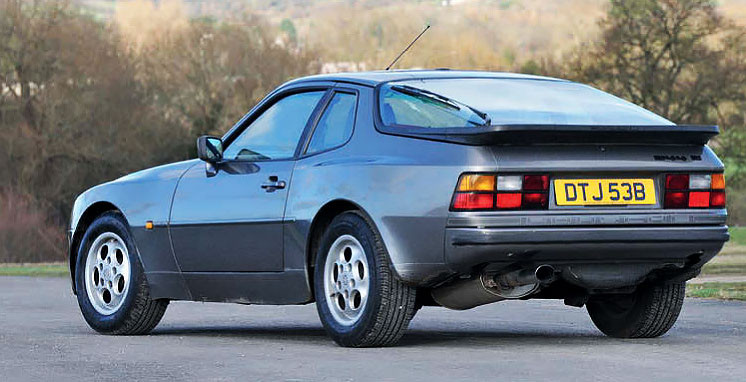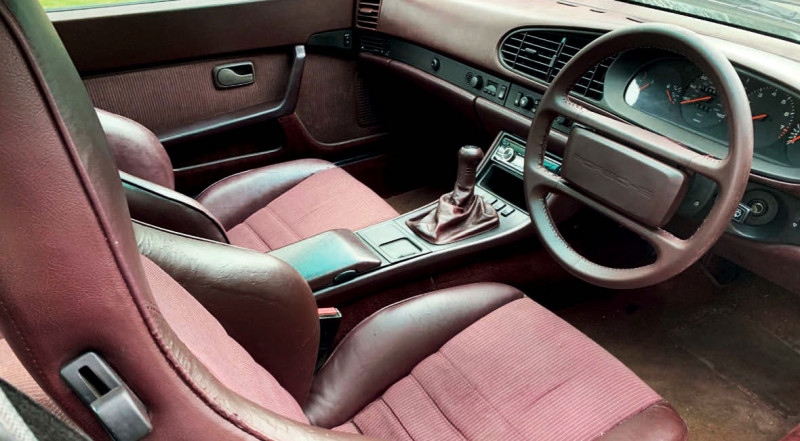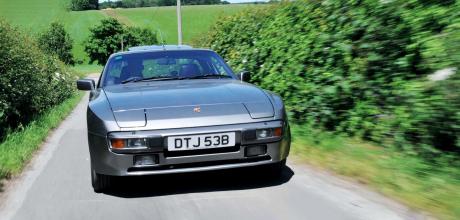1986 Porsche 944S
Every bit the ‘proper’ Porsche, does the 944 stack up as an affordable alternative to the ever more costly 911? We try the 16-valve 944S to find out.
WIDE BOYROAD TEST: PORSCHE 944S
Every bit a proper Porsche, the wide-arched 944 makes a case for itself as an affordable alternative to a classic 911.

For six decades, the Porsche brand has been defined by the iconic silhouette of the 911 and despite an ancient Beetle-era design philosophy which persists today, it’s proved pretty much impossible to replace.
“FOR ANYONE FAMILIAR WITH VW PRODUCTS OF THE MID ’80s, AT FIRST ACQUAINTANCE THE 944 FEELS VERY FAMILIAR”
Not that Porsche didn’t try of course. As early as 1977 the wraps came off the 928 which with its futuristic styling, front engine/rear transaxle layout and all-alloy V8 was as modern as the 911 was dated. It was, of course, very different though and the Porsche faithful largely stayed away, a problem not helped by thePorsche 928 being even more costly than the 911. The result was that the 911 stayed on… and on… and on.

The alternative solution was to improve the firm’s offering at the other end of the range in order to bolster cashflow with a more affordable model. The 914, developed and marketed as a joint-venture with VW had already shown that the idea of a junior Porsche model had some merit and the eventual solution for its replacement would also come courtesy of the VW group.
A longstanding arrangement between VW and Porsche meant that the Stuttgart firm had traditionally been providing the bulk of the R&D work for Volkswagen and had been commissioned to develop a new VW/ Audi coupe.
An Audi 100 engine was chosen, inclined at 30 degrees to allow stylist Harm Lagaay to achieve a suitably low nose, while being Porsche they couldn’t resist putting at least part of the drivetrain in the back, the transaxle gearbox sitting under the boot floor and providing near-perfect weight distribution.
Parts sharing with other VW and Audi models made it relatively cheap to produce and it was all set for launch when VW management, faced with the early ’70s oil crisis and buoyed by the success of the Golf, decided to can the project.
All of which worked in Porsche’s favour as a ready-made replacement for the 914 which with its air-cooled tech was near the end of its shelf life. A design was struck for Porsche to acquire the rights to the design and rather conveniently spare capacity at Audi’s Neckarsulm plant was used to manufacture the car.
The Porsche 924 was launched in November 1975 and although performance was more GTI than 911, the car was a success, especially in the US market. Its fresh, modern styling was a world away from the old 911 and offered a hint of the glamorous 928 at a much more affordable cost.
In 1978 the 170bhp 924 Turbo showed the potential of the basic design, by which time the 924 had become the best-selling car in Porsche’s history, so when the ‘EA831’ VW/Audi engine was set to leave production, the decision was taken to thoroughly overhaul the car and extend its life. Rather usefully, the design of the Porsche 928’s V8 engine had been created to allow the possibility of producing a four-cylinder unit which would effectively be one half of the V8.
Not only would this silence critics claiming that the 924 wasn’t a ‘proper’ Porsche but would also offer much improved performance potential. The 4.5-litre capacity of the 928 engine meant that a single bank worked out at 2.25 litres – an unusually large capacity for a four-cylinder powerplant, especially one destined for a sports car. To avoid an agricultural roughness, the design incorporated twin balancer shafts which ran at twice engine speed and which Porsche optimistically claimed gave the engine the smoothness of a six-cylinder powerplant.
The new engine was to be a 2.5-litre unit in production form which meant retaining the 100mm stroke of the V8 but increasing bore size by 3mm. The end result produced 163 bhp at 5800rpm with 151lbf.ft of torque but its real selling point was Porsche’s claim that over 90 per cent of the maximum torque was available from just 2500rpm.
Since the engine shared the V8’s all-aluminium construction, it was 11kg lighter at 164kg than the 924 engine despite being physically larger. The rest of the running gear followed the layout of the 924, with the transaxle receiving higher fourth and fifth gears plus a strengthened input shaft and the larger-diameter propshaft borrowed from the 924 Turbo. The VW parts were largely abandoned too, with the Beetle-derived rear suspension parts replaced by new Porsche componentry and the interior receiving a makeover with new mouldings and switchgear. The wider body was similar to the style debuted on the limited-production 924 Carrera GT but with the wide arches now in steel, while the 944 sat on identical 7x15 wheels to those found on the 911SC. The end result was a car which had an aggressive stance a world away from the neat but unassuming 924 and Porsche’s aim was to attract new buyers to the brand. The 944 was launched in June 1981 and introduced to the UK in May 1982, positioned as a more conventional, user-friendly model than the more specialised air-cooled cars with a three-speed automatic option offered from the start.
The first big changes arrived in 1985 when the 944 Turbo joined the range boasting 220bhp, lifting top speed above 150 mph and sprinting to 62mph in 6.3 seconds.
A host of upgrades were applied across the 944 range at the same time, including a revised dashboard moulding these days referred to as the ‘Oval dash’. To counter magazine road testers’ criticism of limited wheel-to-knee clearance, the seats were lowered by 30mm and the wheel raised by 18mm. The suspension arms were also cast in aluminium, while changes were made to cylinder head, crankshaft and balancer shafts. A ‘staggered’ wheel option was introduced, using 7x16 front rims and 8x16 rears.
Meanwhile, the 944S model was added to the UK range in September 1986, essentially a 16-valve development of the original engine. The twin-cam head extracted 190bhp from the 2.5-litre engine, giving the car a top speed of 142mph.
A more powerful Turbo model was marketed in a limited run of 1000, running higher boost for 250bhp. Only 70 right-hand drive examples of this 944 Turbo S were officially sold in the UK.
In 1989 the regular eight-valve 944 received a capacity hike to 2.7 litres and later in the year the 944S2 was introduced, incorporating more major modifications: the bore and stroke were increased to give a capacity of 3 litres, producing 211bhp and 207lbf.ft torque.
The same year, the Turbo S specification was standardised for the regular Turbo model. In the spring of 1989, a convertible version of the 944 was announced, offered with the 16-valve 944S2 engine. Production of the 944 would end in 1991, although significant elements of the car would continue in the 968, despite Porsche’s claims that 80 per cent of the car was new.
It’s the 944S we have here which for many enthusiasts is the pick of the models from the original 944 line-up; with more performance than the eight-valve engine, it avoids the complexity of the Turbo and is usefully more affordable than the S2. As regular readers will have noted, this is in fact our own project car, plucked from auction for under £6000 which means that we’ve had rather more time with the car than a quick test drive. For anyone familiar with VW products of the mid ’80s, at first acquaintance the 944 feels very familiar. There may be neat ‘Porsche’ lettering on the door handles but they’re very obviously the same design as you’ll find on Mk1 Golfs and Passats of the era, complete with the awkward trigger which needs a tight squeeze to get into the car.
So many coupes from this era are cut-down hatchbacks that the drop down into the 944’s seats comes as a surprise. With the high-set transmission tunnel, it feels every bit the exotic sports car and the burgundy interior of this car is pure ’80s. Turn the VW-sourced key though and it’s perhaps less exotic. At 2.5 litres, this is a big capacity for a four-cylinder engine and even the balancer shafts can only do so much to smooth out a grumbly idle. Porsche engineers reckoned that the balancer shafts reduced noise levels by 20dB but the trade-off is the whirring which also contributes to the 944’s unique engine note, while all that rotating mass means initial throttle response isn’t as crisp as four-cylinder competition like the Lotus twin-cam or even the BMW straight six.
The long linkage to the rear-mounted gearbox means the shift action can be somewhat rubbery at times, although it’s worlds better than the Alfa 75 and GTV which used the same layout. It needs a firm hand to get the car into gear, but in all other respects the 944 is easy to manoeuvre at low speeds. You’ve got power steering naturally, while the useful torque of the big four-pot and light clutch action mean the car is easy to drive in traffic.
At lower speeds, the difference between the eight-valve car and the ‘S’ is all but invisible, the 16-valve engine’s advantage only appearing at higher revs. This is no Honda experience, but you do need to get it spinning to extract the power – think 4000rpm, at which point it does gather newfound enthusiasm. The headline 190bhp is delivered at 6000rpm, just 200rpm higher than the eight-valve motor but the two are in practice very different in character.
As befits a Porsche, it’s when you drive it hard that the whole design seems to come together. That awkward low-speed gearshift is a whole lot happier at higher speeds, while the brakes are strong and the elegant balance afforded by that 50/50 weight distribution becomes obvious. After a modern sports car or even warm hatch, the 944 feels softly sprung, pitching over undulations and under heavy braking, yet although that might be an impediment on track, it’s no handicap in real-world road use, where the trade-off is a really very civilised ride, assisted by the 215/60 rubber which may be the preserve of vans today but was a low-profile fitment back in the late ’80s.
Much was written back in the day about the 944’s supposedly legendary handling and certainly when compared to the period rear-driven competition it feels massively more secure. Unsurprisingly, it’s set up to tend towards safe understeer initially but even when provoked, the rear doesn’t snap when it lets go – rather it will give you a little warning lurch and is easily gathered back up. Drivers coming from 911s would have been amazed at its composure, while those trading up from a GTI would have found the 944 reassuringly familiar yet with an added poise when driven hard. As for the rest of the experience, the modernisation of the original design which turned 924 into 944 also created a credible contender in the market. Build quality both inside and outside is far ahead of the Lotus Excel and Alfa GTV, while electric windows, seats and mirrors alongside optional air con and ABS allowed the Porsche to stand up against homegrown BMW opposition.
The 944 also offers a style which made BMW’s 6-series E24 look dated and the Lotus look rather home-made, with its broad-shouldered stance giving it superb ’80s appeal which never fails to get approving glances today.
If like us you’ve long ago been priced out of the classic 911 market yet the affordable 996 era and Boxster seem too modern, then the 944 makes a fine alternative as a classic Porsche. Values have been in the doldrums for a long time, certainly for the non-Turbo models, but show signs of picking up lately, which means now is the time to strike. Buy a nice one which hasn’t been messed about with and it should prove an easy ownership proposition with a small investment potential. Oh and the rear seats might be tiny but they’ll do for the school run and you can even get a bike in the hatchback rear if you need further ammunition to get the business case past domestic management.
SPECIFICATIONS 1986 PORSCHE 944S
- ENGINE 2479cc
- MAX POWER 190bhp at 6000rpm
- MAX TORQUE 170lb.ft at 4300pm
- 0-60 MPH 7.9secs
- MAX SPEED 142mph
- ECONOMY 30mpg
- LENGTH 4.2m
- WIDTH 1.7m
- KERB WEIGHT 1280kg
Try doing this with a 911… with its big glass hatch and folding rear seats, the 944 can be surprisingly practical.
The wide arches added to create the 944 served to balance the proportions nicely.
Post-1985 cars are generally referred to as the ‘oval dash’ model for obvious reasons.
The 16-valve head added a useful 30bhp to the 2.5-litre engine.
Low nose was achieved by canting the engine over at 30 degrees.


